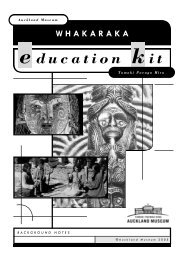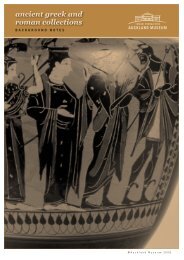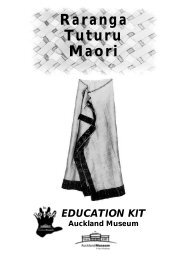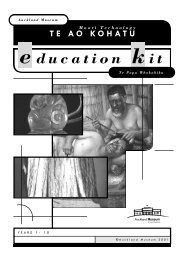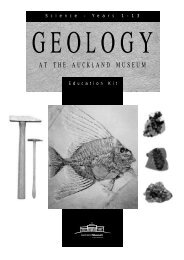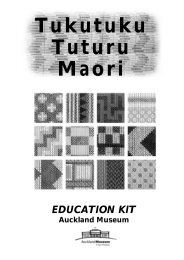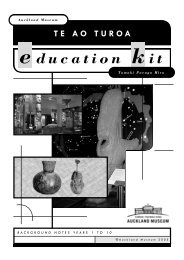You also want an ePaper? Increase the reach of your titles
YUMPU automatically turns print PDFs into web optimized ePapers that Google loves.
teacher background<br />
The Institute's part of <strong>the</strong> <strong>Museum</strong>'s activities represented<br />
<strong>the</strong> educational service <strong>the</strong> <strong>Museum</strong><br />
should give. Their avowed aims were to "advance<br />
<strong>the</strong> diffusion of knowledge and promote alike,<br />
pure taste, intellectual pleasure and material<br />
advancement". They <strong>the</strong>refore held public lectures<br />
and readings of scientific papers, discussions<br />
on literature and art and also established<br />
<strong>the</strong> first School of Art to be based in <strong>the</strong> <strong>Museum</strong>.<br />
A varied selection of classical statuary casts was<br />
imported by Thomas Russell. Sir John Logan-<br />
Campbell funded a tutor and <strong>the</strong> equipment for<br />
students who would sketch <strong>the</strong>se examples of<br />
good taste. Many museums throughout <strong>the</strong> world<br />
used this same technique to assist <strong>the</strong>ir artists.<br />
However, <strong>Auckland</strong>'s statues seem to have been<br />
modest in comparison with some cities, where single<br />
sex viewing was necessary. After 11 years<br />
<strong>the</strong> school closed down as Dr. Elam's bequest<br />
established a new independent art school which<br />
still functions today.<br />
The new <strong>Museum</strong> building seemed ideal initially.<br />
However, in 1892 and 1904 two extensive additions<br />
had to be constructed to one side of <strong>the</strong><br />
building. Enthusiastic collecting by <strong>the</strong> first curator,<br />
botanist Thomas Cheeseman, and fur<strong>the</strong>r public<br />
spirited subscriptions and donations to an<br />
expanding human history collection meant that by<br />
1913 <strong>the</strong> building's space had become totally<br />
inadequate. The Institute and <strong>Museum</strong> Council<br />
interviewed <strong>the</strong> <strong>the</strong>n Prime Minister, <strong>the</strong> Rt. Hon.<br />
W.F. Massey, requesting government aid for<br />
building a new museum on Domain Hill. The<br />
request was granted <strong>the</strong> next year. Unfortunately<br />
<strong>the</strong> outbreak of World War I meant plans had to<br />
be postponed until 1920.<br />
The devastating events of Gallipoli and <strong>the</strong><br />
Western Front had so affected New Zealanders<br />
that <strong>the</strong> concept of a war memorial as part of <strong>the</strong><br />
new <strong>Museum</strong> was enthusiastically embraced. A<br />
citizens committee, which operated for 10 years,<br />
raised 4/5 of <strong>the</strong> necessary funding and ran a<br />
successful competition to select a design for <strong>the</strong><br />
building itself. The three winning architects,<br />
<strong>Auckland</strong> <strong>Museum</strong><br />
Te Papa Whakahiku<br />
Sharing <strong>the</strong> Past<br />
Grierson, Aimer and Draffin, were war veterans.<br />
They based <strong>the</strong>ir design loosely on <strong>the</strong> Grecian<br />
style but more directly on <strong>the</strong> Pennsylvania<br />
Railway station which was in turn based on <strong>the</strong><br />
Roman Baths at Caracella. In line with 'modern'<br />
practice a feature of <strong>the</strong> new building was to be<br />
plentiful natural light, hence <strong>the</strong> huge windows set<br />
into each wall and <strong>the</strong> internal light wells.<br />
Ironically today's scientific evidence suggests that<br />
U.V light is highly destructive, especially of natural<br />
materials, and all <strong>the</strong> windows have had to be<br />
blanked out.<br />
Unfortunately Thomas Cheeseman, <strong>the</strong> curator of<br />
50 years, died in 1923 and was not able to see<br />
this planning come to fruition. Thomas Cheeseman<br />
was an energetic and farsighted individual.<br />
Under his direction <strong>the</strong> <strong>Museum</strong> became a noted<br />
research institution, yet one always in touch with<br />
public needs. Although <strong>the</strong> Princes Street building<br />
was soon too crowded to hold separate exhibitions,<br />
he was in touch with overseas trends and<br />
even at this early time was keen to set aside an<br />
exhibition space especially for children as soon<br />
as larger premises were established. His legacy<br />
to <strong>the</strong> <strong>Museum</strong> was an excellently preserved collection<br />
of 10,000 native plant specimens which is<br />
still widely studied and includes examples of an<br />
extinct plant from <strong>the</strong> Manukau Heads.<br />
A range of innovations was able to be incorporated<br />
in <strong>the</strong> new War Memorial <strong>Museum</strong>. Many<br />
more curators were to be accommodated in <strong>the</strong><br />
new building. A fund established by <strong>the</strong> Carnegie<br />
<strong>Museum</strong>s Trust allowed for a fulltime education<br />
officer to be appointed. Olwyn Turbott was given<br />
<strong>the</strong> task of creating experimental displays, using<br />
<strong>the</strong> latest techniques, aimed at engaging <strong>the</strong> visitor<br />
in a more educational experience. The new<br />
director, Gilbert Archey's special project involved<br />
providing cinema opportunities for <strong>the</strong> public.<br />
Curators were encouraged to make <strong>the</strong>ir own<br />
16mm films on natural history topics. C.W. Dover,<br />
<strong>the</strong> taxidermist, was actively engaged in shooting<br />
birds in <strong>the</strong> Hauraki Gulf so that <strong>the</strong> <strong>Museum</strong><br />
would have <strong>the</strong> freshest possible specimens.<br />
Teacher Background<br />
4



